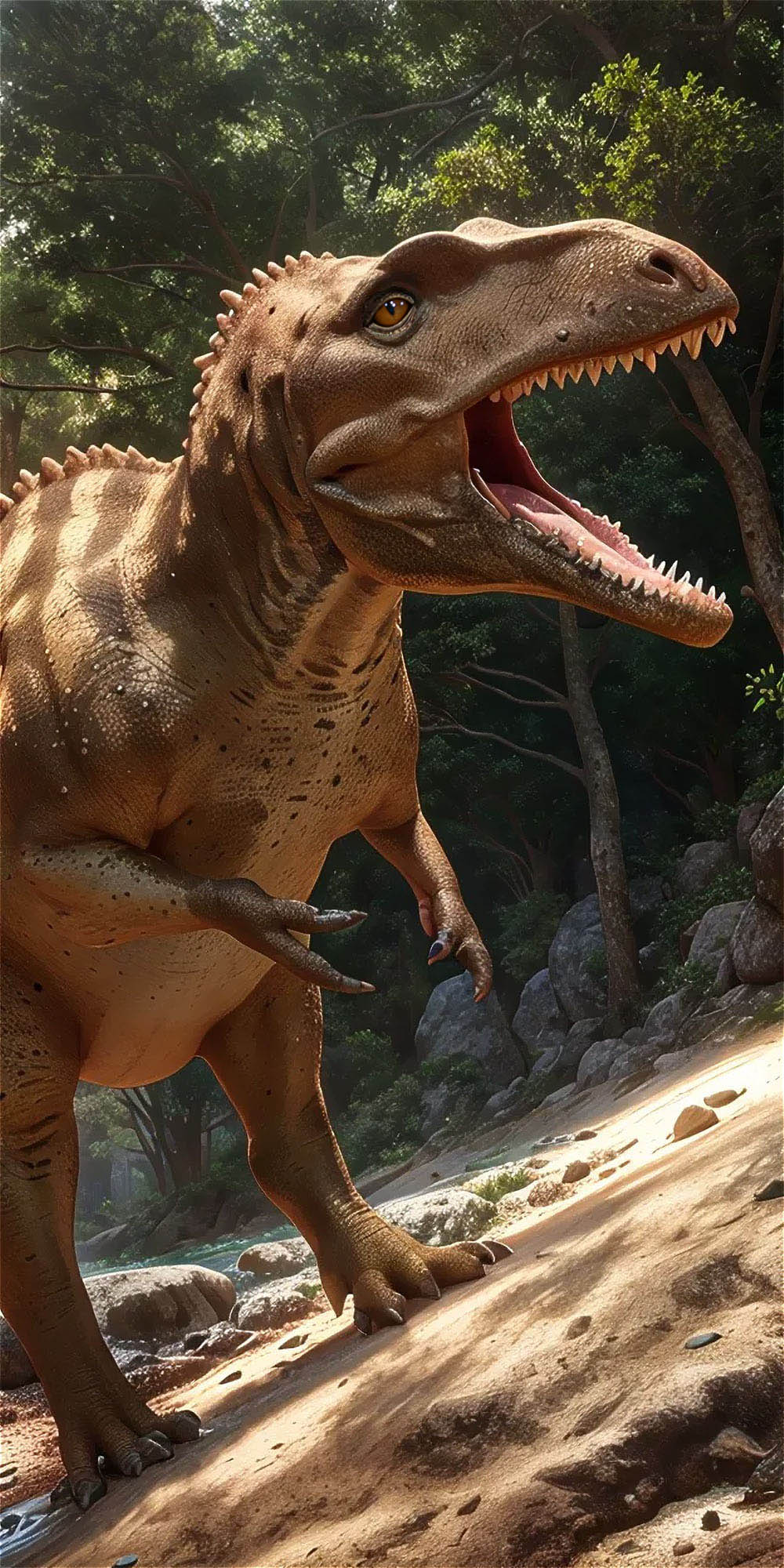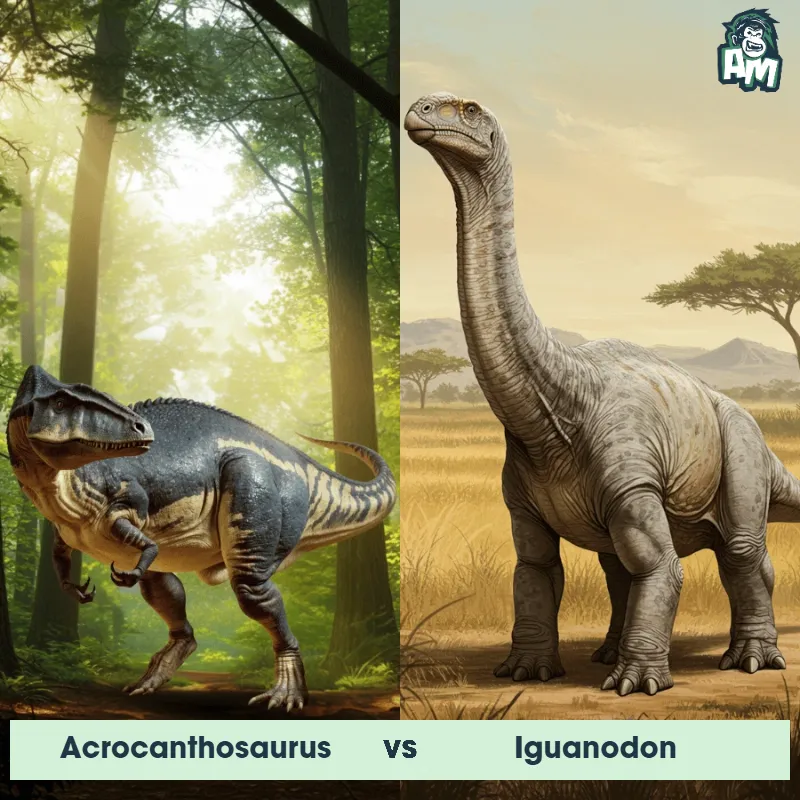The Acrocanthosaurus
The Acrocanthosaurus, also known as the high-spined lizard, was a massive carnivorous dinosaur that lived during the Early Cretaceous period. It was one of the largest predators of its time, measuring up to 38 feet in length and weighing around 6 tons. Acrocanthosaurus had a tall sail-like structure made of elongated neural spines on its back, giving it a distinctive appearance. Its long, powerful jaws were filled with sharp teeth, allowing it to hunt large herbivorous dinosaurs.

| Acrocanthosaurus | |
|---|---|
| Size | Up to 38 feet (11.6 meters) in length |
| Weight | Up to 6 tons (5,443 kg) |
| Speed | 20-30 mph (32-48 km/h) |
| Key Strength | Powerful bite and strong legs |
| Biggest Weakness | Vulnerable underbelly |
| Scientific Name | Acrocanthosaurus atokensis |
| Family | Carcharodontosauridae |
| Habitat | Terrestrial |
| Geography | North America |
| Diet | Carnivorous |
| Lifespan | 25 years - 30 years |

The Acrocanthosaurus
The Acrocanthosaurus, also known as the high-spined lizard, was a massive carnivorous dinosaur that lived during the Early Cretaceous period. It was one of the largest predators of its time, measuring up to 38 feet in length and weighing around 6 tons. Acrocanthosaurus had a tall sail-like structure made of elongated neural spines on its back, giving it a distinctive appearance. Its long, powerful jaws were filled with sharp teeth, allowing it to hunt large herbivorous dinosaurs.
Fun Fact: Acrocanthosaurus had one of the longest tails of any carnivorous dinosaur, which may have helped it balance its massive body while hunting or moving quickly.
| Acrocanthosaurus | |
|---|---|
| Size | Up to 38 feet (11.6 meters) in length |
| Weight | Up to 6 tons (5,443 kg) |
| Speed | 20-30 mph (32-48 km/h) |
| Key Strength | Powerful bite and strong legs |
| Biggest Weakness | Vulnerable underbelly |
| Scientific Name | Acrocanthosaurus atokensis |
| Family | Carcharodontosauridae |
| Habitat | Terrestrial |
| Geography | North America |
| Diet | Carnivorous |
| Lifespan | 25 years - 30 years |
Acrocanthosaurus Matchups
We use AI to simulate matchups between the Acrocanthosaurus and other animals. Our simulation considers size, strength, and natural predatory behaviors to determine the most likely outcome.

Can't find the Matchup you want?
Create Your Own MatchupAcrocanthosaurus: Diet, Predators, Aggression, and Defensive Behaviors
What did Acrocanthosaurus eat?
Acrocanthosaurus were carnivorous dinosaurs that primarily preyed on large herbivorous dinosaurs such as sauropods and ornithopods. Their sharp teeth and powerful jaws allowed them to effectively tear through the flesh and bones of their prey.
Did Acrocanthosaurus have any predators?
As apex predators in their ecosystems, Acrocanthosaurus did not have any natural predators. However, they may have occasionally faced competition for food from other large carnivorous dinosaurs such as Allosaurus or Carcharodontosaurus.
Were Acrocanthosaurus aggressive?
Acrocanthosaurus are believed to have been aggressive hunters, using their size, speed, and strength to take down large prey. Their aggressive nature is also suggested by the morphology of their sharp teeth and powerful limbs, which were adapted for hunting and killing.
Did Acrocanthosaurus fight?
Acrocanthosaurus likely engaged in intraspecific combat with their own kind, especially during territorial disputes or competition for mates. Fossil evidence of injuries on their skeletons, such as broken bones or puncture wounds, suggests that they did engage in fights with other Acrocanthosaurus.
How did Acrocanthosaurus defend themselves?
Acrocanthosaurus relied on their physical attributes, such as their large size, sharp teeth, and powerful legs, to defend themselves against potential threats. They may have also used their speed and agility to evade danger or fight off rival predators.
What was Acrocanthosaurus' biggest weakness in a fight?
Despite their imposing size and strength, the biggest weakness of Acrocanthosaurus in a fight would likely be their agility. While they were powerful predators, they may have been outmaneuvered by smaller, faster predators such as Deinonychus or Utahraptor in a confrontation. Additionally, sustaining injuries during a fight could also weaken their ability to hunt and survive in their environment.
Fun Fact: Despite its size and intimidating appearance, Acrocanthosaurus likely had relatively weak arms compared to its overall body size, making them less useful for grasping or tearing prey.
Fun Fact: Fossil evidence suggests that Acrocanthosaurus may have been a pack hunter, working together with others of its kind to take down larger dinosaurs.











